![]()
![]()
![]()
Use LEFT and RIGHT arrow keys to navigate between flashcards;
Use UP and DOWN arrow keys to flip the card;
H to show hint;
A reads text to speech;
41 Cards in this Set
- Front
- Back
|
What the economic problem? |
Unlimited wants and limited resources |
|
|
3 production questions |
1) What goods and services to produce? 2) How to produce these goods and services? 3) How to allocate these goods and services? |
|
|
What are the factors of production? |
Land, labour, capital and enterprise |
|
|
3 Criteria for economic decision making |
Economic sustainability Environmental Sustainability Social sustainability |
|
|
Specialisation |
Where workers, firms, areas or countries focus on producing a particular good or service |
|
|
Opportunity cost |
The 2nd best alternative that must be given up when scarce resources are used for one purpose instead of another. |
|
|
A market |
A medium where buyers and sellers interact to trade money for goods and services. |
|
|
Market |
The sum of all the buyers and sellers in the area under consideration. |
|
|
The functions of money |
A medium of exchange (makes the exchange of products easier) As unit of account (puts a value on good and services) A store of value (enables people to save) A means of deferred payment (enables people to lend and borrow money) |
|
|
Division of labour |
Specialising in one area means workers can gain greater skill and don't waste time switching between jobs. |
|
|
Benefits of specialisation |
1) Allows firms and countries to focus on what they are best at producing. 2) The quantity and quality of output is higher, and average costs are lower. 3) Increased output leads to lower prices and higher standards of living. |
|
|
Economies of scale |
Producers will specialise in products they are good at making, thus allowing them to produce it more cheaply on a larger scale. |
|
|
3 main economic groups |
Consumers - Buy goods and services Producers - Make and sell goods and services Governments - regulates the industry, provides some goods and services |
|
|
Costs of specialisation |
1) Worker may become bored and dissatified, meaning they will be less productive and are more likely to leave their current job, leading to higher training costs for firms. 2) Low skilled workers only doing one thing have no qualifications for other jobs if they lose their current job. 3) Products lack variety and quality 4) Supply chains become extremely long so it is difficult to see where products may have come from. 5) Automation is easier 6) Depressed regions |
|
|
Specialisation and exchange |
As individuals specialise they will produce a surplus beyond their needs which they can exchange for the surpluses of others. This is domestic or international trade. |
|
|
Characteristics of money |
Generally acceptable Supply must be limited Confidence in source Divisible No intrinsic value Portable Durable |
|
|
Effective demand |
The desire for a good or service supported by the ability and willingness to pay for it. |
|
|
Individual demand |
The demand of just one consumer |
|
|
Market demand |
Total demand for a product from all its consumers |
|
|
Decreases in price lead to... |
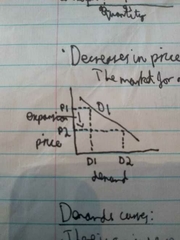
An extension of demand |
|
|
A contraction of demand is caused by... |
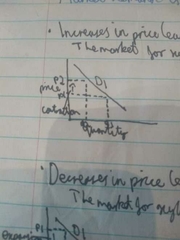
An increase in price |
|
|
There is an _______ relationship between price and quantity demanded |
Inverse |
|
|
A movement along the demand curve is called... |
An extension or a contraction |
|
|
A shift in the demand curve is called... |
An increase or a decrease |
|
|
Primary market |
A market for raw materials |
|
|
Secondary market |
A market for manufactured goods |
|
|
Tertiary market |
A market for services |
|
|
Factor market |
A market for the factors of production |
|
|
Product market |
The market for consumer goods and services |
|
|
An increase in demand |
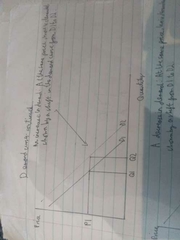
When, at the same price, more is demanded. |
|
|
A decrease in demand |
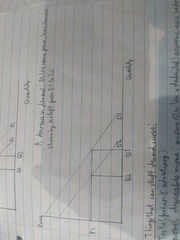
At the same price, less is demanded |
|
|
Things that can shift the demand curve |
1) Taste (fashion and advertising) 2) Income (As disposable income rises so does demand, except for inferior goods). 3) Market size (people entering country/consumer group will increase demand since there are more people buying stuff) 4) Expectations of future price change 5) Seasonal changes (E.g. little demand for Christmas trees in March) 6) The price, quality and availability of substitute goods. |
|
|
Complements |
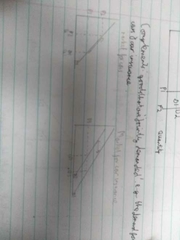
Goods that are jointly demanded (E.g. Cars and car insurance) |
|
|
Graphs must have: |
Title Labelled axes Price written in Quantities written in Curve showing relationship between price and quantity |
|
|
Supply |
The quantity of a good or service that producers are willing and able to supply to the market at a given price in a given time period. |
|
|
Price and quantity supplied have a... |
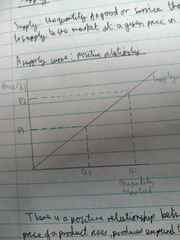
Positive relationship (when the price rises, producers supply more goods and services to the market). |
|
|
The supply curve slopes upwards because... |
1) The profit motive: When the market price rises it becomes more profitable for businesses to increase their output. 2) Production and cost: When output expands, a firm's production costs tend to rise, therefore a higher price is needed to cover the increased costs of production. 3) New entrants to the market: Higher prices may create incentives for other businesses to enter the market, leading to an increase in total supply. |
|
|
An increase in price leads to an... |

Extension in supply (a positive movement along the supply curve). |
|
|
A decrease in price leads to a... |
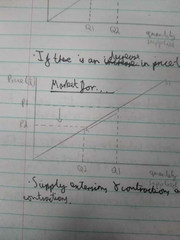
Contraction in supply (a negative movement along the supply curve). |
|
|
A shift in the supply curve is called... |
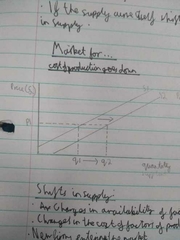
An increase or decrease in supply |
|
|
Factors that cause shifts in the supply curve: |
1) Changes in the cost and availability of the factors of production 2) New firms entering the market 3) Taxes or subsidies 4) Technological advances |

